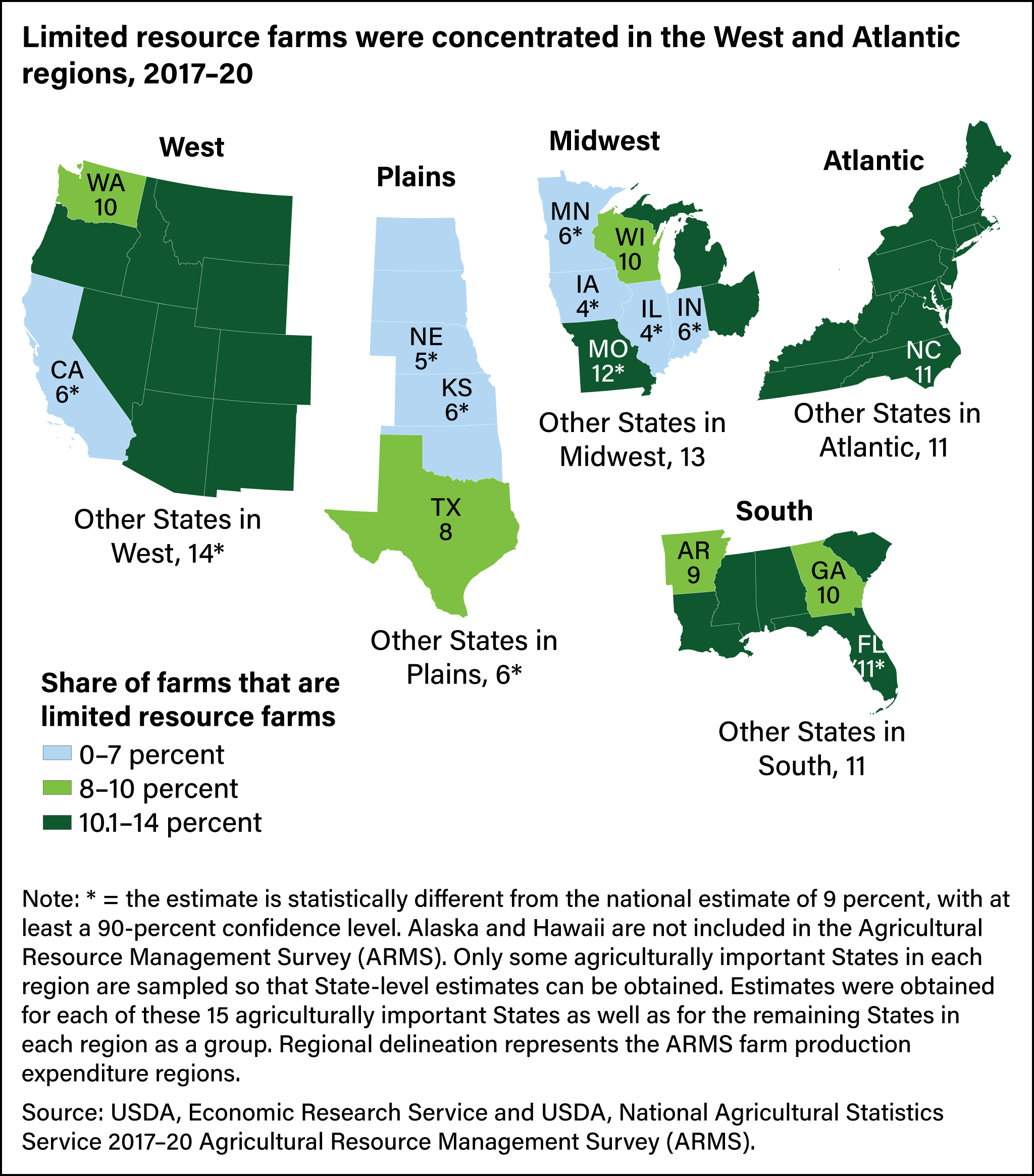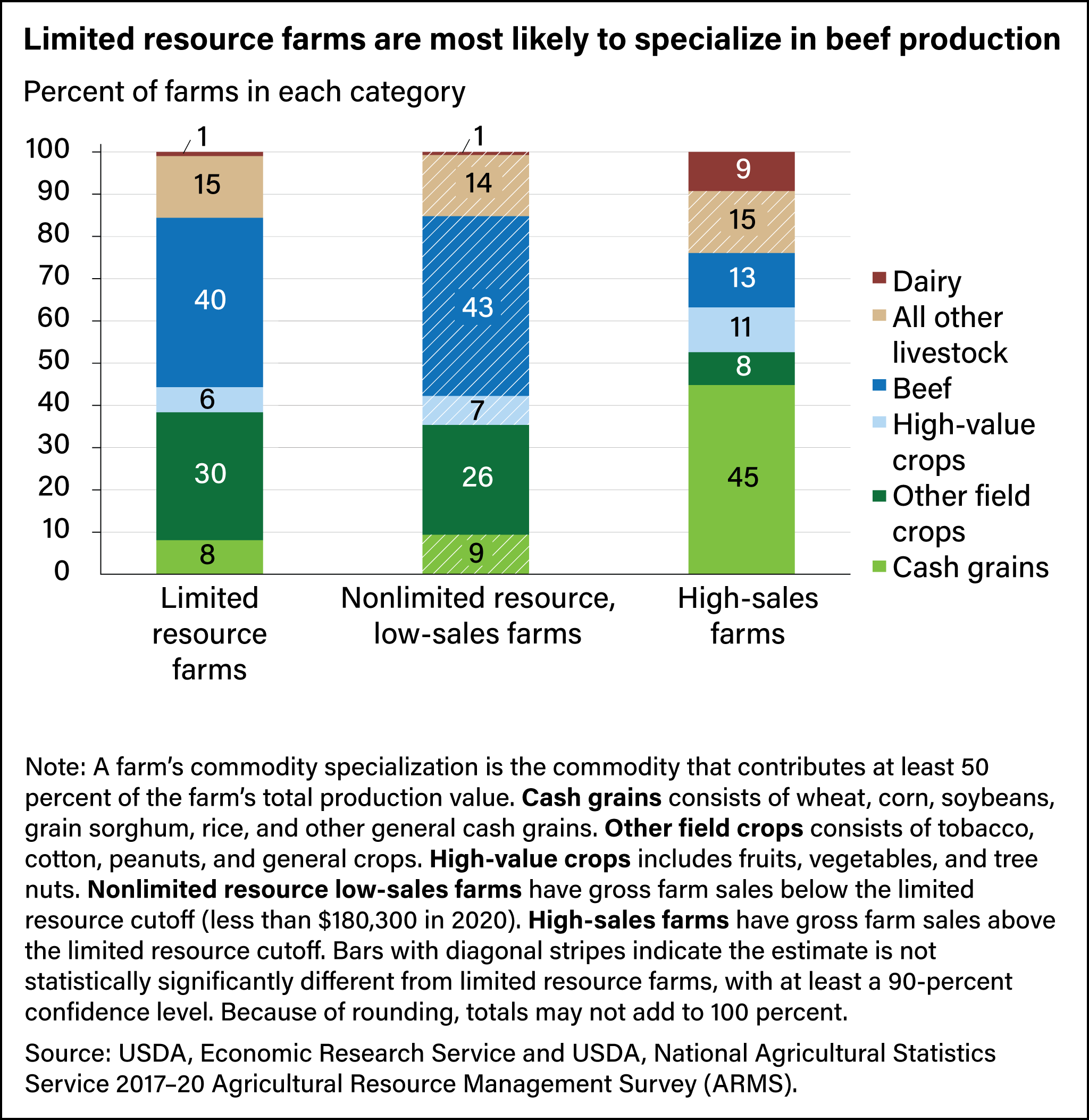
USDA Survey Provides Insights Into Farms Operated by Limited Resource Farmers and Ranchers
- by Nigel Key, Katherine Lacy and Jessica E. Todd
- 10/10/2024
Highlights
- Nationally, about 9 percent of farms were operated by limited-resource producers from 2017 to 2020, but the share varied by region and sometimes across States within a region.
- Although the share of limited resource farms that specialize in each commodity category does not differ from other low-sales farms (both groups specialize in beef production the most), limited resource farms are less likely to receive payments from Government farm programs (21 percent), and those that receive payments receive less on average ($5,366).
- The principal operators of limited-resource farms are less likely to have education beyond high school and are more likely to be at least 65 years old, be female, or be a member of a socially disadvantaged racial group.
- Specifically, 11 percent of principal operators of limited-resource farms are members of socially disadvantaged racial and ethnic groups compared with 7 percent and 3 percent of the principal operators of nonlimited resource low-sales farms and high-sales farms, respectively.
The USDA offers special provisions—including specific incentives, waivers, priorities, set asides, and other flexibilities—for limited resource farmers and ranchers. These are producers who operate farms for 2 consecutive years with low gross farm sales (from either direct or indirect sources) of not more than $180,300 in 2020 dollars, indexed for inflation each year, and whose total household income is either below the poverty level for a family of four or less than half the median household income in the county where they live.
To better understand the characteristics of limited resource producers and the farms they operate, USDA, Economic Research Service (ERS) researchers analyzed data from 4 years (2017 to 2020) of the nationally representative Agricultural Resource Management Survey (ARMS), which identifies limited resource producers. ERS researchers compared farms operated by limited resource producers to two other types of farms: nonlimited resource low-sales farms, which report sales below the limited resource threshold but do not meet either of the limited resource household income criteria; and high-sales farms, which have sales above the limited resource threshold. The researchers found that limited resource farmers and ranchers differ from operators of other farm types in several ways. Limited resource farm principal operators are more likely to be female and to identify as a member of a socially disadvantaged group, and they are less likely to receive Government agricultural payments. They also are less likely to be under 65 years old and less likely than those in the other low-sales group to have 10 years or less farming experience.
Farm Size
Researchers found that between 2017 and 2020, about 9 percent of all U.S. farms were operated by limited resource producers, with the share varying by region and across States within a region. The ARMS data were representative for the 48 contiguous States, and the sample sizes are large enough to provide estimates for 15 agriculturally important States and for an aggregate of the remaining States in 5 regions (see map below). States with relatively high shares of limited resource farms included Missouri (12 percent) and Florida and North Carolina (both with 11 percent). More broadly, the West and Atlantic regions had the highest share of limited resource farms, and the Plains had the lowest share.
Farm Income
Limited resource farms operated about the same number of acres as nonlimited resource low-sales farms, but on average limited resource farms had lower value of production and generated less farm income for the principal operator’s household. Principal operator households of limited resource farms also reported less off-farm income than the other farm types. Off-farm income averaged $15,916 for limited resource farm households compared with $109,546 for nonlimited resource low-sales households and $72,205 for high-sales farm households. The lower off-farm income among limited resource farms is expected given that low total household income is a criterion for being classified as a limited resource farm. The average annual total household income among limited resource principal operators was $6,551 (vs. $110,243 for nonlimited resource low-sales farmers and $232,784 for high-sales farms), which is about 25 percent of the Federal poverty level for a family of four. The average total household net worth among limited resource principal operator households ($842,560) was above that for all U.S. households of any occupation ($748,800) but less than that among nonlimited resource low-sales and high-sales principal operator households.
| Key data | Limited resource farms | Nonlimited resource low-sales farms | High-sales farms |
| Share of all farms (percent) | 9.3 | 76.3 | 14.3 |
| Acres operated (average) | 186 | 195 | 1,675 |
| Total value of production (per-farm average) | $14,435 | $21,033 | $1,102,481 |
| Farm income (average) | -$9,365 | $698 | $160,578 |
| Off-farm income (average) | $15,916 | $109,546 | $72,205 |
| Total household income (average) | $6,551 | $110,243 | $232,784 |
| Net worth (average) | $842,560 | $1,364,860 | $3,673,688 |
| Note: Nonlimited resource low-sales farms have gross farm sales below the limited resource cutoff (less than $180,300 in 2020). High-sales farms have gross farm sales above the limited resource cutoff. Bold type on values indicates a statistically significant difference from limited resource farms, with at least a 90-percent confidence level. Share of all farms does not add to 100 percent because of rounding. Source: USDA, Economic Research Service and USDA, National Agricultural Statistics Service, 2017–20 Agricultural Resource Management Survey (ARMS). |
|||
Farm Specialization
The mix of commodity specializations among limited resource farms is similar to that of nonlimited resource low-sales farms but quite different from high-sales farms. About 8 percent of limited resource farms specialized in cash grains compared with 45 percent of high-sales farms. In contrast, 30 percent of limited resource farms specialized in other field crops, compared with 8 percent of high-sales farms. The greatest share of limited resource farms (40 percent) specialized in beef, compared with 13 percent for high-sales farmers. Limited resource farms were also less likely than high-sales farms to specialize in high-value crops such as fruits and vegetables or in dairy production.
Government Payments
High-sales farms were more likely to receive payments from Government agricultural programs than both types of low-sales farms. Specifically, 65 percent of high-sales farms received Government payments compared with 21 percent of limited resource farms and 28 percent of nonlimited resource low-sales farms. This could be because of the larger share of high-sales farms that specialized in cash grains or dairy, commodities that generally are the focus of Farm Bill programs. Although limited resource farms and nonlimited resource low-sales farms have similar commodity specialization and are of similar size, limited resource farms that received payments received on average $5,366, and nonlimited resource low-sales farms received an average of $7,605. The high-sales farms received $66,071 in government payments during the same period.
| Program type | Limited resource farms | Nonlimited resource low-sales farms | High-sales farms |
| Percent of farms that receive payments | |||
| Total direct agricultural Government payments | 21 | 28 | 65 |
| Conservation payments | 13 | 15 | 24 |
| Direct Federal commodity program payments | 3 | 6 | 37 |
| All other direct Federal, State, and local payments | 9 | 13 | 47 |
| Average U.S. dollars received among recipients | |||
| Total direct agricultural Government payments | 5,366 | 7,605 | 66,071 |
| Conservation payments | 4,545 | 6,832 | 19,022 |
| Direct Federal commodity program payments | 2,908 | 3,623 | 25,878 |
| All other direct Federal, State, and local payments | 5,322 | 6,649 | 61,869 |
| Note: Bold type on values indicates a statistically significant difference from limited resource farms, with at least a 90-percent confidence level. Nonlimited resource low-sales farms have gross farm sales below the limited resource cutoff (less than $180,300 in 2020). High-sales farms have gross farm sales above the limited resource cutoff. Conservation programs include the Conservation Reserve Program (CRP), Environmental Quality Incentives Program (EQIP), and Conservation Stewardship Program (CSP). Direct Federal commodity programs include Agricultural Risk Coverage (ARC), Price Loss Coverage (PLC), and Dairy Margin Coverage. All other Federal, State, and local program payments include agricultural disaster payments and payments through ad hoc programs such as the Market Facilitation Program and the Coronavirus Food Protection Program (CFAP), loans from the Paycheck Protection Program (PPP), advances from the Economic Injury Disaster Loan (EIDL) program, and other agricultural pandemic assistance. Total direct agricultural Government payments is the sum of payments from each of the program types listed. Source: USDA, Economic Research Service and USDA, National Agricultural Statistics Service, 2017–20 Agricultural Resource Management Survey (ARMS). |
|||
Principal Operator Characteristics
The ARMS data also show how the principal operators of limited resource farms differ from those of the other farm types. The principal operators of limited resource farms were generally older, with 55 percent being 65 and older, compared with 39 percent for nonlimited resource low-sales farms and 26 percent of the principal operators of high-sales farms. Principal operators of limited resource farms had also completed fewer years of schooling. For example, 40 percent of the principal operators of limited resource farms completed at least some college, compared with 57 percent of the principal operators of the nonlimited resource low-sales and high-sales farms.
About 11 percent of limited resource principal operators can be classified as socially disadvantaged producers (which USDA defines as those identifying as Hispanic, Black or African American, Asian, American Indian or Alaska Native, or Native Hawaiian or Pacific Islander). In contrast, 7 percent of the principal operators of nonlimited resource low-sales farms are classified as socially disadvantaged producers, and 3 percent of those operating high-sales farms are in that category. Limited resource principal operators also were more likely to be women than the principal operators on nonlimited resource low-sales and high-sales farms. Researchers found 21 percent of limited resource farms had female principal operators, compared with 14 percent for nonlimited resource low-sales farms and 4 percent for high-sales farms. Seventeen percent of limited resource principal operators were beginning farmers, meaning they had 10 years or less of farming experience. This is less than the 21 percent among nonlimited resource low-sales principal operators but more than the 12 percent among high-sales principal operators.
| Characteristics | Limited resource farms | Nonlimited resource low-sales farms | High-sales farms |
| Age (percent) | |||
| Younger than 35 years | 2 | 3 | 6 |
| 35 to 44 years | 4 | 9 | 13 |
| 45 to 54 years | 8 | 15 | 18 |
| 55 to 64 years | 31 | 35 | 37 |
| 65 years or older | 55 | 39 | 26 |
| Education (percent) | |||
| Less than high school diploma | 10 | 4 | 6 |
| High school | 50 | 39 | 38 |
| Some college | 23 | 26 | 29 |
| College graduate and beyond | 17 | 31 | 28 |
| Race/ethnicity (percent) | |||
| Non-Hispanic White | 89 | 94 | 97 |
| Hispanic, any race | 3.7 | 3.5 | 1.8 |
| Non-Hispanic Black | 2.7 | 1.2 | 0.2 |
| Non-Hispanic other than White or Black | 4.9 | 1.8 | 1.3 |
| Female (percent) | 21 | 14 | 4 |
| 10 years or less farming experience (percent) | 17 | 21 | 12 |
| Note: Boldface type on values indicates a statistically significant difference from limited resource farms, with at least a 90-percent confidence level. Nonlimited resource low-sales farms have gross farm sales below the limited resource cutoff (less than $180,300 in 2020). High-sales farms have gross farm sales above the limited resource cutoff. Source: USDA, Economic Research Service and USDA, National Agricultural Statistics Service, 2017–20 Agricultural Resource Management Survey (ARMS). |
|||
This article is drawn from:
- Todd, J.E., Whitt, C., Key, N. & Mandalay, O. (2024). An Overview of Farms Operated by Socially Disadvantaged, Women, and Limited Resource Farmers and Ranchers in the United States. U.S. Department of Agriculture, Economic Research Service. EIB-266.
You may also like:
- Whitt, C. & Todd, J.E. (2021, June 7). Women Identified as Operators on 51 Percent of U.S. Farms in 2019. Amber Waves, U.S. Department of Agriculture, Economic Research Service.
- Beginning, Limited Resource, and Female Farmers and Ranchers. (n.d.). U.S. Department of Agriculture, Economic Research Service.
- Whitt, C., Lacy, K. & Lim, K. (2023). America’s Farms and Ranches at a Glance: 2023 Edition. U.S. Department of Agriculture, Economic Research Service. EIB-263.



